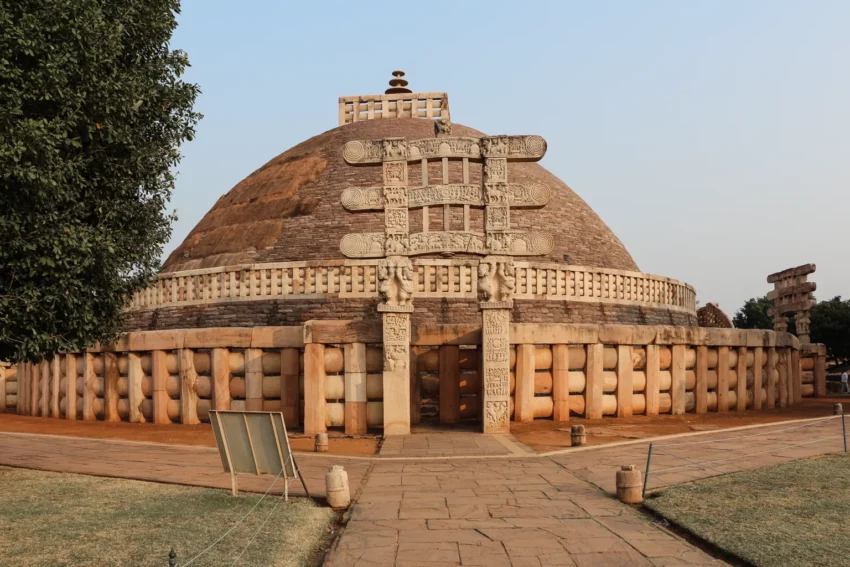Historical Significance of Sanchi Stupa
Sanchi Stupa, located in the Raisen District of Madhya Pradesh, India, stands as a monumental representation of Buddhist architecture and religious heritage. This complex, particularly noted for the Great Stupa, is situated approximately 46 kilometers northeast of Bhopal, the capital of Madhya Pradesh. The site holds immense historical and cultural significance, tracing back to the Mauryan Empire in the 3rd century BC.
Get your dose of History via Email
Origins and Architectural Evolution
The Great Stupa at Sanchi is one of the earliest stone structures in India, originally commissioned by the Mauryan emperor Ashoka the Great around the 3rd century BC. The structure was initially a simple hemispherical brick structure built over the relics of the Buddha, intended to honor and shelter these sacred remains. It featured a chatra, symbolizing high rank, atop the dome.
Significant enhancements were made during the 1st century BC, including the addition of four ornately carved toranas (gateways) and a balustrade that encircled the stupa. These additions marked a significant evolution in the architectural complexity and artistic embellishment of the stupa, reflecting the growing influence and prosperity of Buddhist institutions during this period.
The Stupa Complex and Its Components
The Sanchi Stupa complex expanded over the centuries to include multiple stupas and other religious structures. Notable among these are Stupa No. 2 and Stupa No. 3, each adorned with their own unique reliefs and carvings that depict various aspects of the Buddha’s life and Buddhist mythology. The site also features Temple 40, one of the earliest freestanding temples in India, dating back to the same era as the original stupa construction.
Ashoka’s Pillar
Adjacent to the Great Stupa stands one of the celebrated Pillars of Ashoka. This pillar, originally erected by Emperor Ashoka, is a polished sandstone column that exemplifies the architectural finesse of the period. The capital of the pillar, featuring four lions, is a powerful symbol of Ashoka’s rule and Buddhist law. Although the pillar is partially damaged, it still conveys the imperial patronage that Buddhism enjoyed during Ashoka’s reign.
Archaeological and Cultural Insights
The site of Sanchi offers profound insights into the religious, cultural, and social dynamics of ancient India. The various inscriptions found on the pillars and the stupas provide valuable information about the patronage and the craftsmen who contributed to the building and embellishment of this religious complex. These inscriptions are crucial for understanding the spread of Buddhism and the Mauryan Empire’s role in promoting this religion across the Indian subcontinent.
Preservation and Legacy
Today, the Sanchi Stupa complex is recognized as a UNESCO World Heritage Site, underscoring its importance to global cultural heritage. The site continues to attract scholars, historians, and tourists who are interested in the rich tapestry of India’s religious and architectural history. The depiction of the Great Stupa on the Indian ₹200 currency note further highlights its significance as a symbol of India’s cultural and historical heritage.
In conclusion, the Sanchi Stupa is not merely an architectural feat but also a beacon of the historical and spiritual legacy of Buddhism in India. It stands as a testament to the religious fervor and the architectural ingenuity of ancient India, continuing to draw admiration and scholarly interest from around the world.
Sources:

